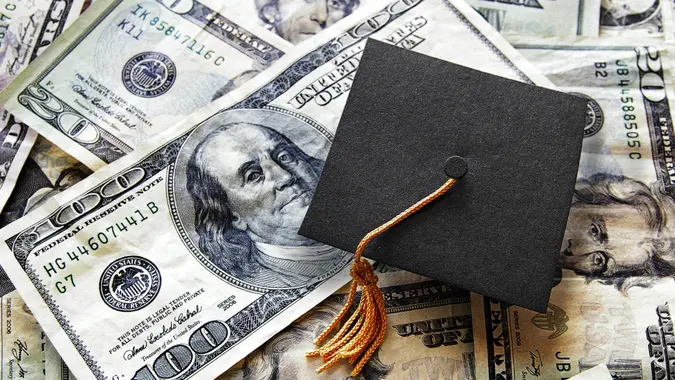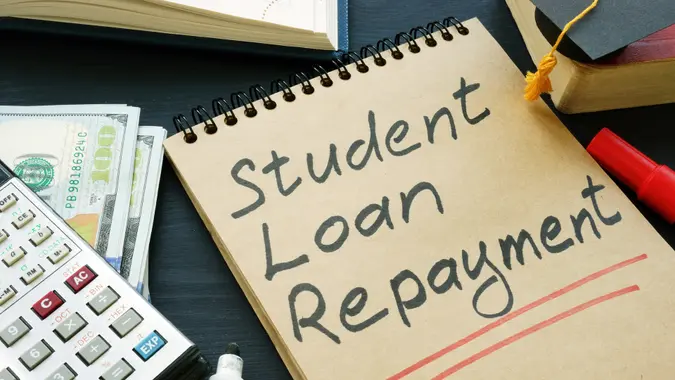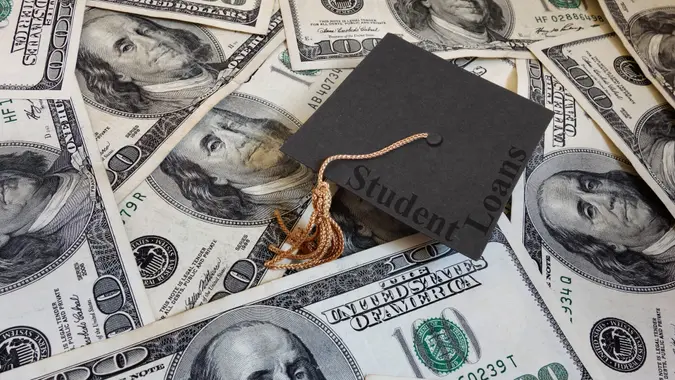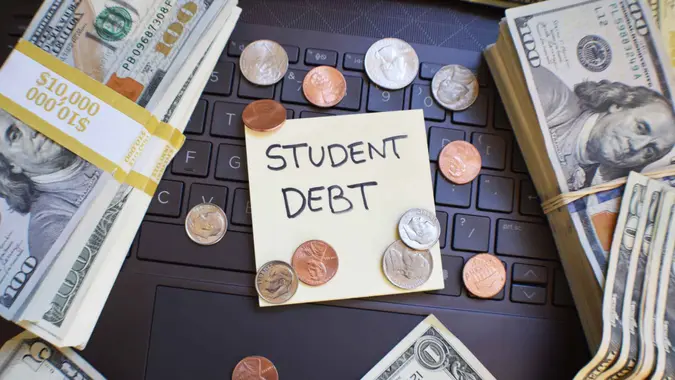Student Loans: How the Supreme Court’s Decision Affects Your Retirement

Commitment to Our Readers
GOBankingRates' editorial team is committed to bringing you unbiased reviews and information. We use data-driven methodologies to evaluate financial products and services - our reviews and ratings are not influenced by advertisers. You can read more about our editorial guidelines and our products and services review methodology.

20 Years
Helping You Live Richer

Reviewed
by Experts

Trusted by
Millions of Readers
The Supreme Court’s 6-3 decision to strike down President Joe Biden’s student loan relief program on June 30 will affect millions of borrowers in several ways. One of them is how the resumption of payments will put a dent in their retirement savings.
A new Fidelity Investments’ 2023 College Savings and Student Debt study found that two in three recent college graduates who were taking advantage of the federal student loan repayment pause say they have no idea how they’re going to start repaying their student loans.
And two-thirds (67%) of recent college graduates with student loan debt say their student loan debt is preventing them from participating in major life milestones such as saving for retirement, getting married or buying a home.
“With the average student debt payment reaching over $400 per month, this is going to feel like taking on a car loan and will put a strain on personal budgets for many borrowers, creating a swirl of uncertainty and call for help,” said Jesse Moore, senior vice president, head of student debt at fidelity.com.
Moore added that the study’s findings are not as much of a surprise as they are cause for concern, as 43 million borrowers will be impacted by this — an unprecedented event for such a large population to either start or restart making these payments again.
“This October will be the first time in over three years that most federal student loan borrowers make a student loan payment, and a lot has changed in three years. These people have bought homes, started families, changed jobs and all have felt the impacts of inflation,” said Moore. “That’s a huge extra expense that many people are not thinking about and will soon need to start budgeting for.”
His advice is to hold that amount back now in a savings account to understand how that will impact people’s budgets and where spending needs to be adjusted.
According to Moore, this will hit particularly the recent graduates who are entering the workforce and some of whom are putting their budgeting skills to the test for the very first time.
“It’s not surprising to see so many borrowers express concern about adjusting their budgets when they already feel like they’re living paycheck to paycheck to make ends meet,” he added.
These findings are in line with a recent TransUnion study, which showed that about 50% of consumers will experience what they deem “a payment shock” with the resumption of payments which are expected to be more than $200 a month with about one in five seeing payments of more than $500.
Yet, to absorb these shocks, there are few steps borrowers can take to prepare, said Moore.
First, get organized.
“We find that most people don’t know where to start, so getting all loan information, interest rates and more is a great first step,” said Moore.
Then, test your budget: put a plan in place to test your budget to ensure you’re working with a realistic budget and you’re comfortable with how much you’re saving and spending.
Finally, talk to your employer and get up to date with what benefits are currently available to you or will become available in the near future.
“It will be important to watch 401k loan rates amongst student loan debt borrowers once payments resume as not only will these borrowers have fewer alternatives to turn to in difficult times, but they could also fall back into a pattern of saving less and withdrawing at a higher rate,” said Moore.
He also noted that employers are seeing the financial and emotional impact that student debt can have on their employees – particularly when it comes to their ability to save for retirement or other life milestones like buying a home.
In turn, some of the most popular ways employers chip in to help are by simply making direct student loan debt payments on behalf of their employees, or by taking advantage of recent changes to retirement laws like SECURE 2.0 that allow companies to contribute a match into a retirement plan when the employee makes a student loan payment.
Other experts agree, saying that with the resumption of payments, employee retirement contributions will likely go down.
“This is a massive amount of investment opportunity being lost-for instance, if Millennial and Gen Z student debt was invested in retirement savings instead, it could be valued at over $20 trillion based on 40 years of compound growth and average annual returns of 6%,” said Dan Macklin, president of Summer.
According to him, the SECURE 2.0 Act that goes into effect next year is not a cure-all but it does offer a major opportunity for employers to match student loan payments with 401k contributions.
“Since this is an employer-driven benefit, it’s something that your workplace would need to offer,” he said. “Per the US Bureau of Labor Statistics, only 68% of Americans have access to employer-sponsored retirement plans. Fortunately, another element of Secure 2.0 is designed to specifically get more employers to sponsor plans. If your employer doesn’t currently offer student loan assistance, that’s likely to change in the coming years due to recent trends in companies adopting these benefits.”
 Written by
Written by 
























